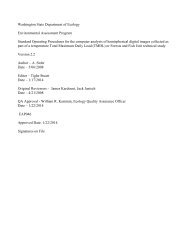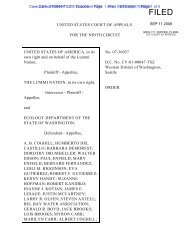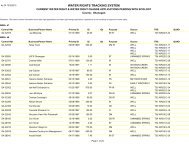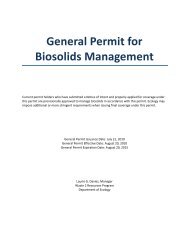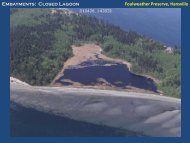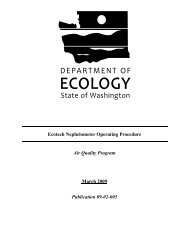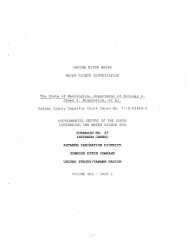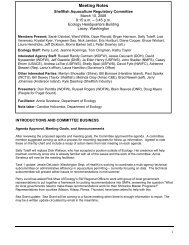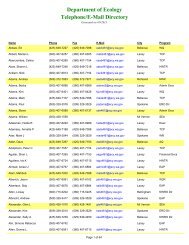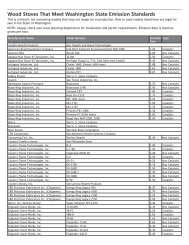WRIA 62 WMP 032305 - Washington State Department of Ecology
WRIA 62 WMP 032305 - Washington State Department of Ecology
WRIA 62 WMP 032305 - Washington State Department of Ecology
You also want an ePaper? Increase the reach of your titles
YUMPU automatically turns print PDFs into web optimized ePapers that Google loves.
March, 2005 -75- 023-1289-003.3040<br />
4.5 Background and Rationale for Growth and Land Use Planning Issues<br />
The following sections provide background information for the growth and land use planning issues.<br />
4.5.1 GR&LU-1 Background and Rationale<br />
Problem <strong>State</strong>ment: There is a need to integrate information on current and future projected<br />
water supply and demand with land use.<br />
The Planning Unit discussed the apparent disconnect between growth and land use planning and<br />
available water resources (for both instream and out-<strong>of</strong>-stream uses). The Planning Unit<br />
recommended that relevant technical information developed within the Phase II technical assessments<br />
(Entrix, 2002; GeoEngineers, 2004; Golder, 2005) be integrated into County, City and Town planning<br />
processes.<br />
Pend Oreille County agreed with the issue and approved the actions. However, they acknowledged<br />
that the County would not be able to take on any further obligations within the current<br />
Comprehensive Plan (tentatively scheduled for completion in June 2005). The County staff indicated<br />
that better integration <strong>of</strong> water supply and growth and land use planning could be considered in future<br />
Comprehensive Plan updates.<br />
4.5.2 GR&LU-2a Background and Rationale<br />
Problem <strong>State</strong>ment: There is a need to identify and assess locations and associated<br />
management practices <strong>of</strong> livestock operations that utilize riparian areas.<br />
There are a number <strong>of</strong> different scales <strong>of</strong> livestock operations within <strong>WRIA</strong> <strong>62</strong>, ranging from small<br />
farms that raise livestock in a relatively small area to large farms and rangeland where livestock roam<br />
year round or seasonally. As indicated on Figure 4-10, the USFS manages the majority <strong>of</strong> the land in<br />
<strong>WRIA</strong> <strong>62</strong>, including a number <strong>of</strong> grazing allotments. The BLM, <strong>State</strong> DNR, private land owners and<br />
the Kalispel Tribe also own land that is used for grazing livestock.<br />
As noted in the <strong>WRIA</strong> <strong>62</strong> Phase II, Level 1 report (Entrix, 2002), improper grazing can reduce<br />
streamside vegetation, which may result in increased water temperature and decreased stream<br />
complexity and habitat diversity. Stream banks are weakened when streamside vegetation is removed<br />
and trampling may result in bank erosion and increased sediment delivery to the stream. Improper<br />
livestock management can also contribute to water quality problems such as high fecal coliform<br />
levels due to manure deposition in and adjacent to the streams. The level <strong>of</strong> negative impact to<br />
riparian vegetation and water quality depends largely upon livestock access to the stream. In areas<br />
that are heavily forested or vegetated, livestock access to the streams can be limited. Conversely, if<br />
the vegetation is primarily grass and open tree stands and the streams are not fenced, livestock access<br />
to the streams can occur frequently and the level <strong>of</strong> impact has the potential to be much greater.<br />
The WPU agreed that there is a need to identify the locations <strong>of</strong> livestock operations within <strong>WRIA</strong> <strong>62</strong><br />
and to assess the degree <strong>of</strong> impact to riparian vegetation and water quality. At present, there are a<br />
number <strong>of</strong> 303(d) listings for temperature and fecal coliform in both the 1998 and draft 2000/2004<br />
listings in <strong>WRIA</strong> <strong>62</strong>. These listings are illustrated on Figures 4-7 and 4-8, respectively. The current<br />
303(d) listings and categorization for <strong>WRIA</strong> <strong>62</strong> streams are available from <strong>Ecology</strong>’s web site at<br />
http://www.ecy.wa.gov/programs/wq/links/impaired_wtrs.html. There may also be other streams <strong>of</strong><br />
concern where data are lacking. It is intended that this action would address those streams for which<br />
data are lacking.<br />
<strong>WRIA</strong> <strong>62</strong> <strong>WMP</strong> <strong>032305</strong>



